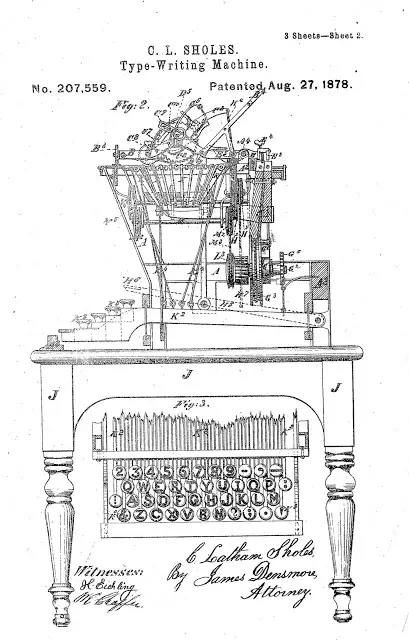When you take a look at a keyboard, the first six letters on the top row give the name of the arrangement of seemingly random letters that we’re all used to using–the QWERTY keyboard. But why was it arranged in this way and not in simple alphabetical order? There is a popularly held belief on why it was done like this, but that belief could be wrong.
Christopher Latham Sholes patented his first typewriter in 1868. It looked like a piano and the letter keys were all in alphabetical order. He modified the key arrangement in 1873 and received a patent in 1878 for a new “Type-Writing Machine,” as it was known. This was the first time the QWERTY keys had been introduced, and are the same as we have today. But why did Sholes change his key layout from alphabetical to the QWERTY style?
The most popularly held theory is that Sholes changed the letter arrangement because when typists would strike the keys on the old layout, the keys would jam because the typebars striking the paper were close to each other. It’s usually stated that he fixed the problem by separating the most commonly used, two-letter combinations, such as “h-e” and “t-h”. It’s believed that James Densmore, a business associate of Sholes, and who also helped him develop his first typewriter, had suggested splitting up the common combinations. It’s also believed that Sholes intended to slow the typist down by arranging the letters on the keyboard in this way, thus leading to fewer mechanical issues.
But there are a few problems with these theories on the origin of the QWERTY keyboard, and a pair of researchers from Kyoto University in Japan refute these commonly held beliefs. Their explanations for the change are rather interesting. They proposed that the QWERTY keyboard arrangement wasn’t made to slow a typist down to reduce mechanical malfunctions, but was, in fact, made to speed up a typist’s ability. A look at Sholes’s history helps to explain why this could have been the case.
One of Sholes’s first customers was Porter’s Telegraph College in Chicago. Edward Porter, the principal of the college, wanted a machine to allow telegraph operators to write what they received on a Morse telegraph. Sholes also met later with businessmen from the American Telegraph Works. After each meeting, slight modifications of the keyboard layout were completed. Since telegraph operators receiving Morse code had to equal the speed of the operator sending the Morse code, the changes in the keyboard layout may have come directly from the telegraph operators so they could keep up their speed transcribing the messages.
The theory that QWERTY was developed to separate common, two-letter combinations is also odd since two of the most common combinations, “e-r” and “r-e” are right next to each other on the QWERTY keyboard, and were also next to each other on the typebars that struck the paper for each letter. It seems Densmore and Sholes would have realized these combinations were commonly used, and wouldn’t have put them together if they had wanted to reduce mechanical malfunctions of their typewriters. Despite the inconsistencies with how the QWERTY keyboard originated, it is a well-known fact that it has had significant staying power. In 1873, Sholes went into a business arrangement with Remington, the gun-maker, to manufacture his typewriter, and right before production of the machine began, he filed his QWERTY patent that was eventually issued in 1878.
By 1890, QWERTY keyed Remington typewriters numbered more than 100,000. In 1893, the five biggest typewriting manufacturers merged into the Union Typewriter Company and held the QWERTY keyboard as their standard. This is when another odd theory about the origin of the QWERTY keyboard pops up. It has also been theorized that the keys were used for marketing since the word “typewriter” could be spelled out using the top line of the keys and to impress customers by typewriter salesman, but this hardly makes sense as something that would be important for marketing or would have fit in with the timing of when Sholes developed the new keyboard.
But Remington did establish the QWERTY system, and since many people were already trained on the QWERTY keyboard, it became entrenched since companies didn’t want to have to retrain someone on a new system. This was good for Remington because it ensured that companies would continue to use their typewriters. Sholes continued to work on improving his typewriter designs and key layouts, even after selling his patent to Remington. But he wasn’t entirely satisfied with the QWERTY key layout. A year before his death in 1890, he filed another patent for a typewriter with a completely different key layout.
The QWERTY keyboard lives on, and even though there have been other alternatives to it, none have been able to knock it from its perch. But a new layout could do just that, and it might have the ability because of the way we type nowadays, just as the telegraph operators did. It’s called KALQ, and it’s based on the way we type a growing majority of the time now…with our thumbs.
Sources: Smithsonian, Kyoto University Research



